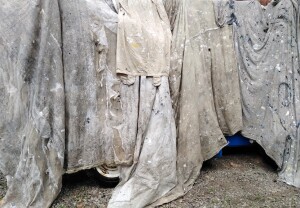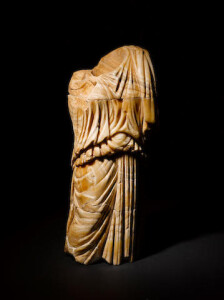It looks here as if I haven’t written anything for months, so I thought I’d add this link to a piece I wrote for Art in Liverpool, which tells something of my time spent during lockdown. It focuses on my daily walks to Crosby Beach in the company of Antony Gormley’s iron men – Lockdown Walking to Another Place.
Meanwhile, much more exciting, at least to me, is that the outside of the house where I live is being painted. Today, rain stopped play, as they say, and the large “cherry picker” brought in to reach the gutters and the top windows, was temporarily grounded.  The decorators used all their dust sheets to cover it, seemingly to hide it in case a passing somebody might decide to take it for a joy ride.
The decorators used all their dust sheets to cover it, seemingly to hide it in case a passing somebody might decide to take it for a joy ride.
The result of the disguise is, I think, visually brilliant – straight out of art history’s draped sculpture tradition. I love that it looks as if there’s a whole crowd of people sheltering under there, or anyway, definitely not practising social distancing. Often in ancient draped  sculptures of the human form it was only the tips of the feet that were visible, and here, as if to emulate that, you can just glimpse one of the machine’s wheels.
sculptures of the human form it was only the tips of the feet that were visible, and here, as if to emulate that, you can just glimpse one of the machine’s wheels.
A few years ago a 1st century Roman alabaster draped female figure, part of The Geddes Collection (left), was sold at Bonham’s London Auction House for £27,000. I don’t think my cherry picker will quite reach that amount! The tradition of draped figures continues with modern sculptors such as Henry Moore and Ralph Brown – whilst the artist, Alison Watt, has produced exquisite huge paintings of the drapery itself, sometimes enlarging a small detail of folds from a work by an Old Master. I was fortunate to see one of these frequently when I lived in Edinburgh – it is called “Still” and is on permanent display at Old St Paul’s Church, just near Waverley Station.
The church itself was built as a memorial to all the young men from the Parish who died during WW1. Richard Holloway, former Bishop of Edinburgh, describes the painting thus: “There is a sense of latency and loss in the painting; but it also establishes a feeling of hope, a sense that, against all hope, hope yet remains”. And in these strange and unsettling times of the Covid 19 pandemic, hope is definitely something to hold onto.